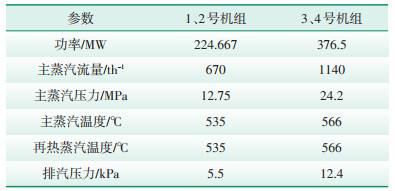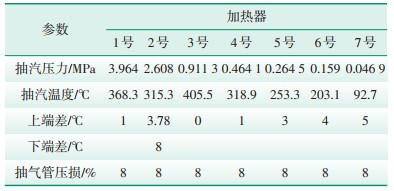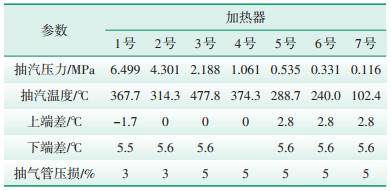2. 内蒙古电力(集团)有限责任公司呼和浩特供电分公司, 呼和浩特 010020
2. Inner Mongolia Power(Group) Co., Ltd., Hohhot Power Supply Company Branch, Hohhot 010020, China
截至2022年8月底,全国可再生能源发电装机总量达到6.9亿kW,其中风电、太阳能发电装机容量分别同比增长16.6%、27.2%[1]。随着可再生能源发电的大规模并网,传统火电机组逐步从主体能源过渡至基础能源,发挥“托底保供”作用。为了进一步消纳风、光发电,维持电网稳定运行,亟需充分挖掘燃煤供热机组的深度调峰潜力[2]。
目前,以抽汽供热为主的热电联产系统可调节负荷范围窄,调峰能力较差[3]。为打破“以热定电”模式中电、热双负荷约束对供热机组的可行域及深度调峰能力的限制,国内外学者提出众多改造技术,主要有蓄热供热、高低压旁路供热、电锅炉等热电解耦技术[4-8],以及针对汽轮机本体进行改造的低压缸零出力、光轴等技术[9-12]。局文平[13]等对当下常用的供热改造技术进行了整理分析。甘益明等[14]总结了储热型与非储热型热电解耦技术发展现状,分析了各技术在供热机组深度调峰应用中的优缺点。张龙英等[15]建立了某300 MW机组调峰预测模型,得出了该机组供热可行域。上述多以单台机组或单供热模式为研究对象,对于厂级多机组、多供热模式,其热-电-能效耦合关系更复杂[3]。宋浩等[16]以2×300 MW供热机组为研究对象,分析了多供热机组多调峰模式协同运行对全厂供热能力、调峰性能和经济性的影响,得出了最优协同运行方式。陈晓利等[17]针对某地区2×350 MW供热机组,提出四种深度调峰协同运行方案,研究各方案对机组负荷的影响,得到最优多供热机组协同运行方式。
综上所述,为准确评估多供热机组在深度调峰模式下协同运行的工作性能,本文基于Ebsilon仿真软件对某电厂2×200 MW、2×350 MW共4台供热机组进行了热力系统建模。分析了切缸、高背压、光轴多种深度调峰技术协同运行对供热机组的影响,在电-热双负荷约束下,分析了多机组、多供热模式下厂级的经济性能和深度调峰性能,可为电厂进行相关供热改造提供参考。
1 数学模型 1.1 机组概况本文研究对象为内蒙古某电厂2×200 MW、2×350 MW四台供热机组。其中,2×200 MW(1、2号)机组汽轮机为C145/N200-12.75/535/535型,2×350 MW(3、4号)机组汽轮机为CZK350/290-24.2/0.4/566/566型。
为增加电厂供热能力,满足外部热网需求,对1、3号机组进行了低压缸切缸/低背压运行改造,改造后引入40 t/h蒸汽冷却低压缸,以防止低压缸叶片温度过高,其余中压缸排汽用于采暖抽汽。对2号机组进行了光轴改造,将原低压缸转子更换为光轴转子,彻底解列低压缸运行,同时引入5.0 t/h蒸汽冷却光轴。对4号机组进行了高背压改造,利用机组乏汽余热提高供热能力,一部分低压汽缸排汽进入高背压凝汽器,其余排汽进入空冷岛[18-23]。
1.2 机组设计数据以机组阀门全开工况(Valve Wholve Open,VWO)为基准,表 1列出了各机组VWO工况主要参数,表 2列出了各机组抽汽供热工况主要参数,表 3为1、2号机组热力系统的主要参数,表 4则是3、4号机组热力系统的主要参数。
| 表 1 VWO工况下各机组主要参数 Table 1 Main parameters of each unit in VWO condition |
| 表 2 各机组抽汽供热工况主要参数 Table 2 Main parameters of pumping steam heating condition of each unit |
| 表 3 1、2号机组热力系统主要参数 Table 3 Main parameters of thermal system of Unit 1 and 2 |
| 表 4 3、4号机组热力系统主要参数 Table 4 Main parameters of thermal system of Unit 3 and 4 |
基于质量平衡和能量守恒,利用Ebsilon软件建立了四台供热机组主要设备数学模型,1、2号机组计算模型如图 1所示,3、4号机组计算模型如图 2所示。
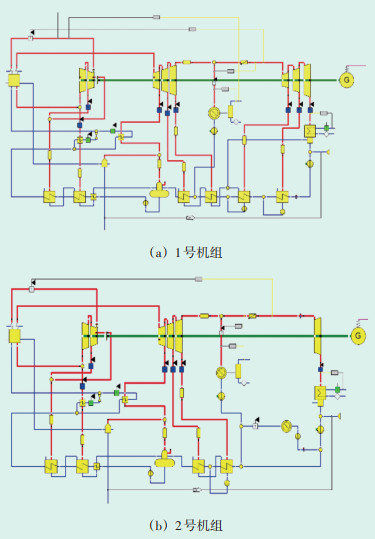
|
| 图 1 1、2号机组热力性能计算模型 Figure 1 Thermodynamic performance calculation model of Unit 1 and Unit 2 |
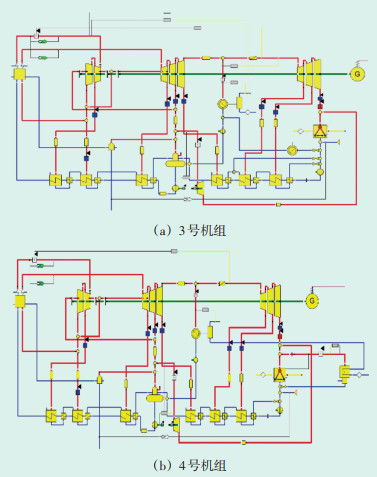
|
| 图 2 3、4号机组热力性能计算模型 Figure 2 Thermodynamic performance calculation model of Unit 3 and Unit 4 |
根据厂家提供的热平衡图对数学模型精度进行了验证,在机组VWO、热耗率验收工况(Turbine Heat Acceptance,THA)、部分负荷纯凝、额定供热等工况下,将各机组数学模型的仿真功率与热平衡图的设计值进行了比较,如图 3、图 4所示。结果表明,四台供热机组数学模型仿真功率与设计功率相比,最大误差为1.5%,模型精度满足工程需要[23-26]。
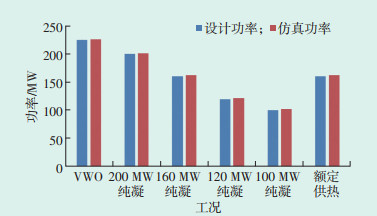
|
| 图 3 1、2号机组数学模型的仿真功率与设计功率的对比 Figure 3 Comparison of simulation power and design power of mathematical models of Unit 1 and 2 |
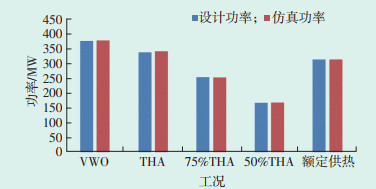
|
| 图 4 3、4号机组数学模型仿真功率与设计功率的对比 Figure 4 Comparison of simulation power and design power of mathematical models of Unit 3 and 4 |
供热机组热力性能由热量分配法计算,热耗率q0计算公式为:

|
(1) |
式中:h0—主蒸汽比焓,kJ/kg;
hfw—给水比焓,kJ/kg;
hrh1—再热蒸汽热端比焓,kJ/kg;
hrh2—再热蒸汽冷端比焓,kJ/kg;
D0—主蒸汽流量,kg/h;
Drh—再热蒸汽流量,kg/h;
Dfw—给水流量,kg/h;
Dh—采暖抽汽流量,kg/h;
hh—采暖抽汽比焓,kJ/kg;
hdh—供热回水比焓,kJ/kg;
Pe—供热机组发电功率,kW。
机组的标准煤耗率由式(2)计算:

|
(2) |
式中:bes—机组标准煤耗率,g/kWh;
ηb—锅炉效率,取95%;
ηp—管道效率,取99%。
1.4.2 供热机组经济效益评估供热机组经济效益评估需考虑售电收益、售热收益、深度调峰补偿收益及燃煤成本,单位时间内厂级供热机组净效益为:

|
(3) |
式中:Etotal—厂级供热机组净收益,元/h;
Ee—售电收益,元/h,Ee = Pece,其中ce为上网电价,取值0.3元/kWh;
Eh—售热收益,元/h,Eh = Qhch,其中Qh为供热负荷,GJ/h,ch为供热售卖单价,取值25元/GJ;
Ccoal—燃煤成本,元/h,Ccoal = 700Bcoal,其中Bcoal为供热机组煤耗量,t/h;
Ep—供热机组深度调峰补偿收益。Ep由式(4)计算,根据电力市场运营规则,供热机组负荷率达50%以下时按0.25元/kWh进行效益补偿。

|
(4) |
式中:Pen—供热机组额定功率,kW。
2 计算结果及分析 2.1 低压缸零出力改造性能分析以1号机组为研究对象,图 5给出了低压缸零出力模式对供热机组调峰性能的影响,随着机组供热量增加,原抽凝机组和切缸改造后机组的最小出力负荷均增加。供热量为160 MW时,抽凝供热模式和切缸供热模式对应的最小电负荷差值最大,达到33 MW;供热量相同时,切缸运行可以有效降低机组发电功率,有利于实现机组深度调峰。
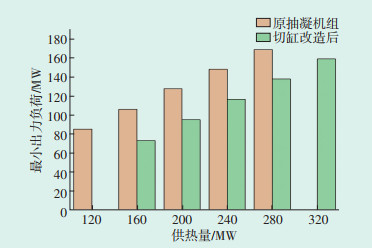
|
| 图 5 切缸改造对供热机组最小出力的影响 Figure 5 Impact of cutting cylinder transformation on the minimum output of heating units |
图 6为低压缸零出力改造前后供热机组净收益的变化。供热量小于180 MW时,切缸供热模式净收益高于原机组抽凝供热模式,在此供热负荷区间,供热机组切缸运行可获得较高的调峰收益补偿,当供热量为160 MW时,调峰收益补偿为6 733.5元/h。当供热量大于180 MW时,原机组抽凝供热模式运行净收益高于切缸供热模式,随着供热负荷增加,机组售电效益和售热效益增加,调峰补偿逐步减少直至无补偿收益,在此区间内,原机组抽凝供热模式净效益更高。
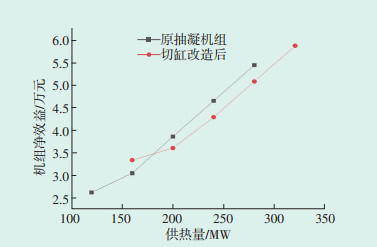
|
| 图 6 切缸改造对供热机组净收益的影响 Figure 6 Impact of cutting cylinder transformation on the net income of heating units |
图 7给出了4号机组改造前后供热可行域,在不同供热负荷下,对原机组抽凝供热模式与高背压供热进行了对比。由图 7可知,随着供热量增大,原供热机组的最大出力负荷和高背压改造后机组的最大出力负荷均降低。供热量相同时,高背压运行时的机组最大出力高于抽汽供热时的最大出力。供热量为400 MW时,最大出力提升约33 MW,最小出力降低约80 MW。高背压改造最小出力先减少后增大,这是由于在供热量为250 MW时最小出力负荷率达到最小负荷稳燃率,供热量增大时(175~250 MW),低压缸进汽量减少,做功减少。由图 7可知,高背压改造后增加了机组可运行范围,调峰能力增强。
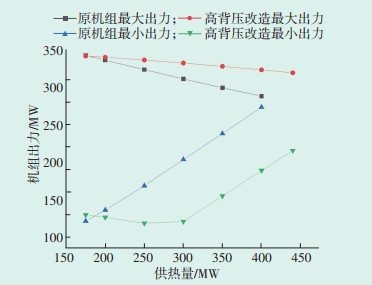
|
| 图 7 4号机组供热可行域 Figure 7 Feasible area for heating of Unit 4 |
图 8给出了在不同供热模式下机组净效益情况。以供热量相同时机组最大出力为参考,可以看出,随着供热量增大,高背压运行净效益和抽汽供热运行净效益差值越来越大,供热量为400 MW时,两种供热模式效益差值达到9804元/h。在供热量175~325 MW区域内,高背压最小出力净收益更高,主要是由于在此范围内可以获得较高的调峰补偿。在325~400 MW区域内,调峰补偿减少,原抽汽供热机组售电、售热效益更高。
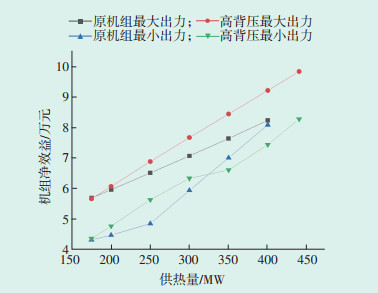
|
| 图 8 不同供热模式效益对比 Figure 8 Comparison of benefits of different heating modes |
该厂四台机组分别为2个热网系统供热,1、2号机组为同一热网供热,3、4号机组为另一热网供热。同一热网系统内的机组可按照原抽凝供热模式运行或按照改造后供热模式运行,因此可构成4种供热运行方式。方式1是四台机组全部采用抽凝方式进行供热运行;方式2为四台机组全部由改造后供热模式运行(1、3号机组切缸改造、2号机组光轴改造、4号机组高背压改造);方式3为1、2号按照原机组抽汽供热,3号机组切缸改造,4号机组高背压改造;方式4为1号机组切缸改造、2号机组光轴改造,3、4号按照原机组抽汽供热。
图 9为不同供热方式对厂级调峰性能的影响。在不同供热量下,方式2厂级发电功率始终为最小值,深度调峰能性能最好。当供热量为800 MW时,方式2比方式1厂级最小电负荷降低了155 MW;供热量为1200 MW时,方式2比方式1厂级最小电负荷降低了220 MW;供热量为800 MW时,方式4比方式3的厂级最小电负荷降低了21.7 MW;供热负荷较高时(1000~1400 MW),方式3的厂级最小电负荷均小于方式4。
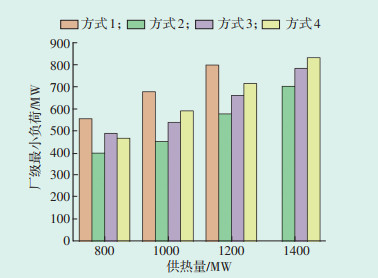
|
| 图 9 供热方式对厂级调峰性能的影响 Figure 9 Effect of heating mode on plant level peak regulation performance |
图 10为不同供热方式对厂级净收益的影响。由图 10可知,在供热量较低时(800~1000 MW),得益于调峰补偿政策,方式2厂级净收益最高。在供热量为1000~1200 MW时,调峰补偿收益减少,方式1(四台抽凝供热机组)售电、售热效益增加,净收益最高;供热量为1400 MW时,各机组几乎达到最大供热工况。从全厂范围内看,三种供热方式净效益差距不大,方式4厂级净效益比方式1多1.25万元/h。
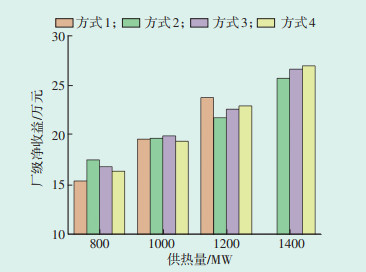
|
| 图 10 供热方式对厂级净收益的影响 Figure 10 Effect of heating mode on plant level net income |
供热机组运行时,其最小出力负荷不仅与主汽量和供热量有关,还受机组背压、疏水温度、供热压力等因素影响。图 11—13给出了背压、疏水温度、供热压力对机组最小出力的影响,四台机组的验证均以各自最大供热工况为准。由图 11、12可知,背压与疏水温度对机组最小出力负荷的影响不大。由图 13可知,供热压力增大时,各台机组最小出力均降低,这是因为供热压力增大时,蒸汽在高、中压缸做功减少,功率降低。供热压力从0.2 MPa增加至0.6 MPa时,4号高背压机组最小出力负荷降低最多,为67.8 MW。图 14为供热压力对机组净效益的影响,随着供热压力增加,各机组净效益降低,这是因为在各机组最大供热工况下其最小出力负荷达不到调峰补偿要求,随着供热压力的增大,最小出力负荷降低,售电收益减少,机组的净效益降低。其中3号切缸机组净效益降低最多,为1.48万元/h。
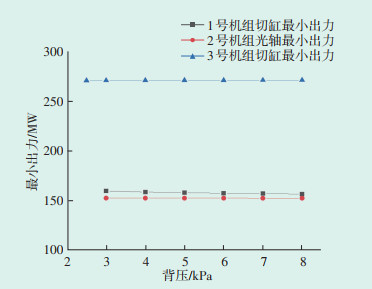
|
| 图 11 背压对机组最小负荷的影响 Figure 11 Effect of back pressure on minimum load of the unit |
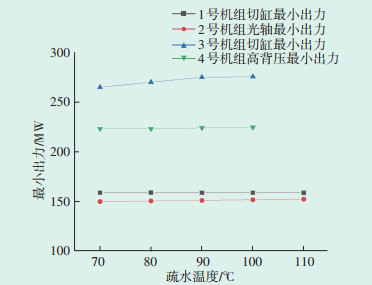
|
| 图 12 疏水温度对机组最小负荷的影响 Figure 12 Effect of drain temperature on minimum load of the unit |
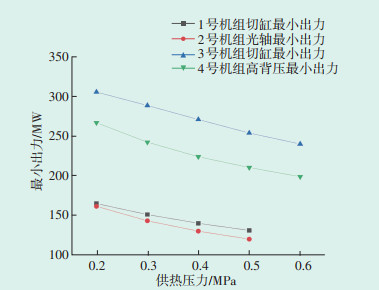
|
| 图 13 供热压力对机组最小出力的影响 Figure 13 Effect of heating pressure on minimum output of the unit |
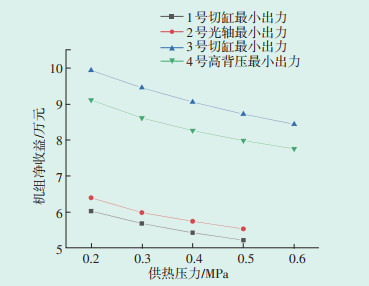
|
| 图 14 供热压力对机组净效益的影响 Figure 14 Effect of heating pressure on the net benefit of the unit |
本文通过构建2×200 MW、2×350 MW四台供热机组数学模型,研究了多台供热机组在多供热模式下厂级的经济性能、深度调峰性能。并提出4种厂级供热运行方式,对低压缸零出力、高背压两种供热改造技术及机组背压、疏水温度、供热压力对调峰性能的影响进行分析。结果表明,低压缸零出力和高背压供热均有利于实现机组深度调峰;从厂级视角看,各供热机组存在最佳的运行方式。研究结论对于提高供热机组的调峰能力、优化供热机组的运行方式具有一定的指导意义。
| [1] |
中电联. 2022年1~8月份电力工业运行简况[N]. 中国电力报, 2022-09-23(002).
(  0) 0)
|
| [2] |
王茂贵, 吕洪坤, 李剑. 浙江省燃煤机组深度调峰综述[J].
浙江电力, 2019, 38(5): 90-97 WANG Maogui, LYU Hongkun, LI Jian. Review on Deep Peak Regulation of Coal-fired Generating Units in Zhejiang Province[J]. Zhejiang Electric Power, 2019, 38(5): 90-97 (  0) 0)
|
| [3] |
石慧, 王洋, 马汀山, 等. 多机组、多模式的热电联产厂级供热优化[J].
热力发电, 2022, 51(1): 123-129 SHI Hui, WANG Yang, MA Tingshan, et al. Multi-unit and multi-mode co-generation plant heating optimization[J]. Thermal Power Generation, 2022, 51(1): 123-129 (  0) 0)
|
| [4] |
王建峰, 刘沛奇, 杨用龙, 等. 300 MW热电机组热电解耦灵活性改造[J].
浙江电力, 2022, 41(2): 98-102 WANG Jianfeng, lIU Peiqi, YANG Yonglong, et al. Flexibility Retrofit of Heat and Power Decoupling of a 300 MW Thermal Power Unit[J]. Zhejiang Electric Power, 2022, 41(2): 98-102 (  0) 0)
|
| [5] |
郭良丹, 谭锐, 林宝森, 等. 提高供热机组的调峰灵活性研究[J].
中国测试, 2022, 48(7): 16-22 GUO Liangdan, TAN Rui, LIN Baosen, et al. Study on improving the flexibility of peak regulation of heating units[J]. China Measurement & Testing Technology, 2022, 48(7): 16-22 (  0) 0)
|
| [6] |
王占洲, 曹丽华, 董恩伏, 等. 基于旁路系统提升热电机组风电消纳能力研究[J].
太阳能学报, 2021, 42(1): 317-323 WANG Zhanzhou, CAO Lihua, DONG Enfu, et al. Research on improving the absorption capacity of wind power of thermal power units based on bypass system[J]. Acta Energiae Solaris Sinica, 2021, 42(1): 317-323 (  0) 0)
|
| [7] |
郑飞, 陈晓利, 高继录, 等. 抽汽供热机组深度调峰灵活性改造技术研究[J].
汽轮机技术, 2021, 63(2)144-146, 150 ZHENG Fei, CHEN Xiaoli, GAO Jilu, et al. Research on deep peak regulation flexibility transformation technology of exhaust steam heating unit[J]. Turbine Technology, 2021, 63(2)144-146, 150 DOI:10.3969/j.issn.1001-5884.2021.02.019 (  0) 0)
|
| [8] |
陈家伦, 蒋欢春, 卞韶帅, 等. 660 MW梯级供热机组耦合电锅炉运行优化[J].
中国电力, 2022, 55(5): 189-195 CHEN Jialun, JIANG Huanchun, BIAN Shaoshuai, et al. Operation optimization of coupled electric boiler in 660 MW cascade heating unit[J]. Electric Power, 2022, 55(5): 189-195 (  0) 0)
|
| [9] |
鄂志君, 张利, 杨帮宇, 等. 低压缸零出力实现热电联产机组热电解耦与节能的理论研究[J].
汽轮机技术, 2019, 61(5)383-386, 391 E Zhijun, ZHANG Li, YANG Bangyu, et al. Theoretical study on thermoelectric decoupling and energy saving of cogeneration units with zero output of low-pressure cylinder[J]. Turbine Technology, 2019, 61(5)383-386, 391 DOI:10.3969/j.issn.1001-5884.2019.05.017 (  0) 0)
|
| [10] |
谢昌亚, 陈凯亮, 刘广会, 等. 350 MW供热机组低压缸零出力试验及仿真研究[J].
热能动力工程, 2022, 37(7): 1-9 XIE Changya, CHEN Kailiang, LIU Guanghui, et al. Zero output test and simulation study of low-pressure cylinder of 350 MW heating unit[J]. Journal of Engineering for Thermal Energy and Power, 2022, 37(7): 1-9 (  0) 0)
|
| [11] |
汪可, 田亮. 供热机组低压缸零出力工况下热经济性分析[J].
华北电力大学学报(自然科学版), 2023, 50(4)112-118, 126 WANG Ke, TIAN Liang. Analysis of heat economy under low-pressure cylinder zero output condition of heating unit[J]. Journal of North China Electric Power University(Natural Science Edition), 2023, 50(4)112-118, 126 DOI:10.3969/j.ISSN.1007-2691.2023.04.12 (  0) 0)
|
| [12] |
管洪军, 李洪波, 李宏伟, 等. 热电厂低压缸光轴改造对其流动与换热性能影响的研究[J].
汽轮机技术, 2021, 63(4)289-292, 296 GUAN Hongjun, LI Hongbo, LI Hongwei, et al. Study on the influence of low-pressure cylinder optical shaft modification on flow and heat transfer performance in thermal power plant[J]. Turbine Technology, 2021, 63(4)289-292, 296 (  0) 0)
|
| [13] |
居文平, 吕凯, 马汀山, 等. 供热机组热电解耦技术对比[J].
热力发电, 2018, 47(9): 115-121 JU Wenping, LYU Kai, MA Tingshan, et al. Comparison of thermoelectric decoupling technology of heating unit[J]. Thermal Power Generation, 2018, 47(9): 115-121 (  0) 0)
|
| [14] |
甘益明, 王昱乾, 黄畅, 等. "双碳" 目标下供热机组深度调峰与深度节能技术发展路径[J].
热力发电, 2022, 51(8): 1-10 GAN Yiming, WANG Yuqian, HUANG Chang, et al. Development path of deep peak shaving and deep energy-saving technology of heating units under the goal of "double carbon"[J]. Thermal Power Generation, 2022, 51(8): 1-10 (  0) 0)
|
| [15] |
张龙英, 张学镭, 原树峰, 等. 300 MW供热机组调峰性能及其影响因素研究[J].
汽轮机技术, 2016, 58(5): 391-395 ZHANG Longying, ZHANG Xuelei, YUAN Shufeng, et al. Study on peak shaving performance and influencing factors of 300 MW heating unit[J]. Turbine Technology, 2016, 58(5): 391-395 (  0) 0)
|
| [16] |
宋浩, 陈晓利, 高继录, 等. 多供热机组多模式深度调峰协同运行技术路线研究[J].
汽轮机技术, 2021, 63(6)448-450, 457 SONG Hao, CHEN Xiaoli, GAO Jilu, et al. Research on multi-mode deep peak regulation collaborative operation technology route of multi-heating unit[J]. Turbine Technology, 2021, 63(6)448-450, 457 (  0) 0)
|
| [17] |
陈晓利, 宋浩, 高继录, 等. 供热机组多模式深度调峰协同运行技术研究[J].
汽轮机技术, 2021, 63(2): 151-153 CHEN Xiaoli, SONG Hao, GAO Jilu, et al. Research on multi-mode deep peak regulation collaborative operation technology of heating unit[J]. Turbine Technology, 2021, 63(2): 151-153 (  0) 0)
|
| [18] |
王金星. 大型燃煤热电联产系统研究现状和展望[J].
华北电力大学学报(自然科学版), 2019, 46(6): 90-98 WANG Jinxing. Research status and prospect for large coal-fired combined heat and power generation system[J]. Journal of North China Electric Power University(Natural Science Edition), 2019, 46(6): 90-98 (  0) 0)
|
| [19] |
何志瞧, 陈巍文, 张江丰. 660 MW超临界机组深度调峰试验及低负荷段经济性分析[J].
浙江电力, 2020, 39(6): 68-73 HE Zhiqiao, CHEN Weiwen, ZHANG Jiangfeng. Deep Peak Regulation Test and Economic Efficiency Analysis for the 660MW Supercritical Unit under Low Load[J]. Zhejiang Electric Power, 2020, 39(6): 68-73 (  0) 0)
|
| [20] |
刘双白, 张晶, 吴昕, 等. 320 MW机组低压缸零出力性能分析及应用研究[J].
中国电力, 2021, 54(5): 213-220 LIU Shuangbai, ZHANG Jing, WU Xin, et al. Zero output performance analysis and application research of low-pressure cylinder of 320 MW Unit[J]. Electric Power, 2021, 54(5): 213-220 (  0) 0)
|
| [21] |
谢天, 杨荣祖, 程东涛, 等. 低压缸零出力供热工况中低压缸连通管内部流动数值模拟[J].
热力发电, 2021, 50(11): 99-106 XIE Tian, YANG Rongzu, CHENG Dongtao, et al. Numerical simulation of internal flow in low-pressure cylinder interconnecting pipe under zero-output heating condition[J]. Thermal Power Generation, 2021, 50(11): 99-106 (  0) 0)
|
| [22] |
刘勇, 刘涛, 李鹏. 330 MW东方汽轮机低压缸零出力改造案例研究[J].
机电工程技术, 2019, 48(9): 237-242 LIU Yong, LIU Tao, LI Peng. Case Analysis of Low Pressure Cylinder Zero Output Retrofit of 300 MW Oriental Steam Turbine[J]. Mechanical & Electrical Engineering Technology, 2019, 48(9): 237-242 (  0) 0)
|
| [23] |
张少强, 陈露, 刘子易, 等. 大型燃煤锅炉深度调峰关键问题探讨[J].
南方能源建设, 2022, 9(3): 16-28 ZHANG Shaoqiang, CHEN Lu, LIU Ziyi, et al. Discussion on Key Problems of Depth Peak Adjustment for Large Coal-Fired Boilers[J]. Southern Energy Construction, 2022, 9(3): 16-28 (  0) 0)
|
| [24] |
冯澎湃, 王宁玲, 杨志平, 等. 直接空冷高背压供热机组的梯级供热特性与冷端变工况协同优化[J].
中国电机工程学报, 2016, 36(20)5546-5554, 5731 FENG Pengpai, WANG Ningling, YANG Zhiping, et al. Cascade Heating Characteristics and Off-design Collaborative Optimization of Direct Air-cooled High Pressure Heat Supply Power Units[J]. Proceedings of the CSEE, 2016, 36(20)5546-5554, 5731 (  0) 0)
|
| [25] |
马可心, 陈晓利, 宋浩, 等. 300 MW级供热机组多模式深度调峰协同运行技术路线研究[J].
东北电力技术, 2021, 42(11): 5-7 MA Kexin, CHEN Xiaoli, SONG Hao, et al. Study on Technical Route of Multi-Mode Deep Peak Shaving Cooperative Operation for 300 MW Heating Units[J]. Northeast Electric Power Technology, 2021, 42(11): 5-7 (  0) 0)
|
| [26] |
胡绍宇, 张强, 褚云山, 等. 300 MW燃煤机组供热工况时协调控制策略研究及应用[J].
东北电力技术, 2022, 43(12)1-2, 5 HU Shaoyu, ZHANG Qiang, CHU Yunshan, et al. Research and Application of Coordinated Control Strategy for Heating Conditions of 300 MW Thermal Power Coal-Fired Units[J]. Northeast Electric Power Technology, 2022, 43(12)1-2, 5 (  0) 0)
|
 2023, Vol. 41
2023, Vol. 41


